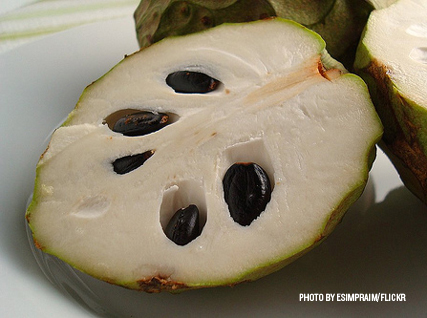 WHAT? Apple of their eye. In Uncommon Fruits and Vegetables, Elizabeth Schneider describes this knobby, gray-green fruit as "stunning," and writes that it tastes "heavenly." Mark Twain was also a fan. Upon trying the sweet, delicately flavored fruit, he pronounced it "deliciousness itself." The cherimoya originated in the Caribbean, and was conveyed around the world by Spanish and Portuguese colonists. Its leaves, roots, and seeds have long been used in traditional medicine as a cure-all for any number of ailments from diarrhea and itchy skin to fainting spells and rheumatism; it was also used to repel lice. We prefer to eat it. The flesh is white, pulpy, and slightly granular, and its taste has been likened to pineapple, banana, papaya, vanilla, and custard. In fact, cherimoya also goes by the name custard apple, as do several other closely related tropical fruits. The simplest way to enjoy it is to cut it in half, then scoop up the flesh with a spoon, navigating around the many large brown seeds. Writes Schneider, "If you do not fall in love at first bite, try again: chances are good that one of the varieties will delight."
WHERE? Jim Foss and Abdul Hash Housh's Beard House dinner
WHEN? April 7, 2010
HOW? Pistachio Nougatine with Phyllo, Valrhona Chocolate–Orange Blossom Glaze, and Cherimoya Ice Cream
WHAT? Apple of their eye. In Uncommon Fruits and Vegetables, Elizabeth Schneider describes this knobby, gray-green fruit as "stunning," and writes that it tastes "heavenly." Mark Twain was also a fan. Upon trying the sweet, delicately flavored fruit, he pronounced it "deliciousness itself." The cherimoya originated in the Caribbean, and was conveyed around the world by Spanish and Portuguese colonists. Its leaves, roots, and seeds have long been used in traditional medicine as a cure-all for any number of ailments from diarrhea and itchy skin to fainting spells and rheumatism; it was also used to repel lice. We prefer to eat it. The flesh is white, pulpy, and slightly granular, and its taste has been likened to pineapple, banana, papaya, vanilla, and custard. In fact, cherimoya also goes by the name custard apple, as do several other closely related tropical fruits. The simplest way to enjoy it is to cut it in half, then scoop up the flesh with a spoon, navigating around the many large brown seeds. Writes Schneider, "If you do not fall in love at first bite, try again: chances are good that one of the varieties will delight."
WHERE? Jim Foss and Abdul Hash Housh's Beard House dinner
WHEN? April 7, 2010
HOW? Pistachio Nougatine with Phyllo, Valrhona Chocolate–Orange Blossom Glaze, and Cherimoya Ice Cream
 WHAT? Apple of their eye. In Uncommon Fruits and Vegetables, Elizabeth Schneider describes this knobby, gray-green fruit as "stunning," and writes that it tastes "heavenly." Mark Twain was also a fan. Upon trying the sweet, delicately flavored fruit, he pronounced it "deliciousness itself." The cherimoya originated in the Caribbean, and was conveyed around the world by Spanish and Portuguese colonists. Its leaves, roots, and seeds have long been used in traditional medicine as a cure-all for any number of ailments from diarrhea and itchy skin to fainting spells and rheumatism; it was also used to repel lice. We prefer to eat it. The flesh is white, pulpy, and slightly granular, and its taste has been likened to pineapple, banana, papaya, vanilla, and custard. In fact, cherimoya also goes by the name custard apple, as do several other closely related tropical fruits. The simplest way to enjoy it is to cut it in half, then scoop up the flesh with a spoon, navigating around the many large brown seeds. Writes Schneider, "If you do not fall in love at first bite, try again: chances are good that one of the varieties will delight."
WHERE? Jim Foss and Abdul Hash Housh's Beard House dinner
WHEN? April 7, 2010
HOW? Pistachio Nougatine with Phyllo, Valrhona Chocolate–Orange Blossom Glaze, and Cherimoya Ice Cream
WHAT? Apple of their eye. In Uncommon Fruits and Vegetables, Elizabeth Schneider describes this knobby, gray-green fruit as "stunning," and writes that it tastes "heavenly." Mark Twain was also a fan. Upon trying the sweet, delicately flavored fruit, he pronounced it "deliciousness itself." The cherimoya originated in the Caribbean, and was conveyed around the world by Spanish and Portuguese colonists. Its leaves, roots, and seeds have long been used in traditional medicine as a cure-all for any number of ailments from diarrhea and itchy skin to fainting spells and rheumatism; it was also used to repel lice. We prefer to eat it. The flesh is white, pulpy, and slightly granular, and its taste has been likened to pineapple, banana, papaya, vanilla, and custard. In fact, cherimoya also goes by the name custard apple, as do several other closely related tropical fruits. The simplest way to enjoy it is to cut it in half, then scoop up the flesh with a spoon, navigating around the many large brown seeds. Writes Schneider, "If you do not fall in love at first bite, try again: chances are good that one of the varieties will delight."
WHERE? Jim Foss and Abdul Hash Housh's Beard House dinner
WHEN? April 7, 2010
HOW? Pistachio Nougatine with Phyllo, Valrhona Chocolate–Orange Blossom Glaze, and Cherimoya Ice Cream






